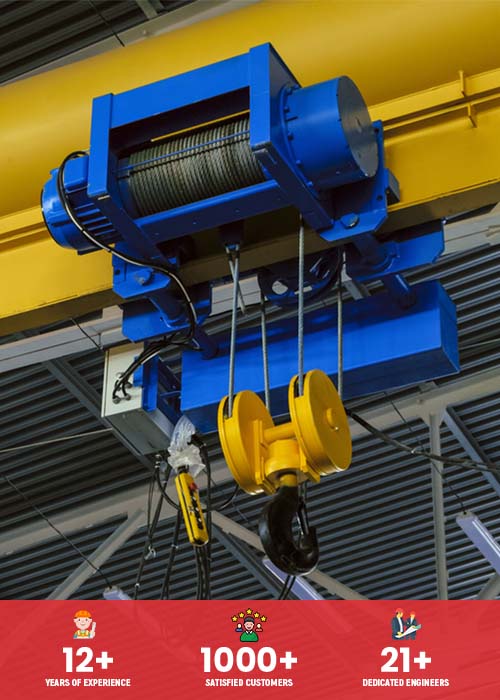12 + YEARS
OF EXPERIENCE
1000 + SATISFIED CUSTOMERS
1 + OWNED OFFICE IN INDIA
21 + DEDICATED ENGINEERS
Guide Krishna Crane Engineers
Gears Motors

Units in which the prime mover and the speed reduction unit are joined together to make a single compact unit are called Gear motors. Here prime movers are the speed reduction unit is the gearbox. Since this arrangement makes the use of alternative coupling, it saves a lot of time and also it allows the shaft of the motor to protrude inside the gearbox. In order to ensure compactness, the motor and the gearbox might be separated firstly and then bolted together. Also for ensuring compactness, the electrical and the mechanical components may be enclosed in a common housing.
Geared motors are classified into two categories depending upon the type of mountings and the internals used
- Flanged-mounted
- Foot-mounted
Both the above geared motors are used in industries for rolling mills and textile machines and for the variety of other appliances which are usually meant for small power applications.
According to the gearing system used and keeping in mind the internals these motorised speed reducers can be categorised below.
Warm gear Motor
Warm type gear motors are normally used for quiet operations, high speed reduction ratio and right angled shaft axes.
Helical gear Motor
Helical gear motors are used for inline or parallel shaft type speed reducers and for intermediate speed reductions.
Bevel gear Motor
Bevel gear motors are used for power transmissions at angular sharps.
When it comes to considering the economy and compactness in the designed criteria, planetary gears are usually used for considerable speed reductions.
Selection procedure for standard gear boxes.
Exceptional specialization in the field is required in order to manufacture standard worm helical, spur & other types of gear boxes. The firms manufacturing these gear boxes offer a detailed technical literature and information consisting of product range as well the data to select the appropriate type and size of gear boxes.
Exceptional specialization in the field is required in order to manufacture standard worm helical, spur & other types of gear boxes.The firms manufacturing these gear boxes offer a detailed technical literature and information consisting of product range as well the data to select the appropriate type and size of gear boxes.
In order to select the right type and size of gear box the data consisting of both the prime one and the driven machine are required.
Factors responsible for classifying a gearbox are its size, rated power, maximum speed, maximum torque capacity reduction ratio input and output speed and any dimensional constraints if applicable. In order to select the correct gearbox the following guidelines or steps must be followed.
- The actual power required in order to drive the machine at the desired speed must be calculated.
- The load which the driven machine is going to encounter during its service must be determined.
- The duration of service and the type of load must be identified depending upon the prime mover.
- Equivalent power must be calculated using the relation equivalent power = Actual power x Service factor.
- It is extremely important to select the right size of the gearbox from the manufacturers catalogue.
Gears

For transferring the rotational motion accurately between two shafts, gears are used. Gears can increase/ decrease torque while decreasing/increasing the rotational speed of the shaft respectively. There are different types of gears which have different usage from an engineer’s point of view.
Combination of multiple sets of gears that can achieve higher gear ratios in sufficient large product sizes are called large gear boxes.
In a typical hob-cut gearbox axes must be parallel as the teeth are also parallel to the axis of the shaft. These gears produce considerably high noise if they run in high speed applications as the teeth do not engage graduall.
If helical gears are to be compared with spur gears the former are more suited for applications with high speed since the teeth engagement is more gradual as compared to latter. Spur gears engage instantly along the line across the whole tooth. Whereas helical gears on the other hand engage at a point developing into a line of contact and then separating at a single point.

This reduces noise considerably in the tooth. The shaft access of a helical gear can be rotated at any angle as the shape of the tooth is a segment of helix. In these gears the thrust is generated along the shaft access which needs to be encountered with thrust or spherical bearings.
Double Helical Gears

Double helical gears which are also known as herringbone gears are the solution for axial thrust present in helical gears. In terms of manufacturing double helical gears are comparatively complex to manufacture.
Bevel gears are made up of two conically profiled gears present in cross section hypothetical vertices of whom intersect. Teeth in bevel gears can either be straight or spiral cut.
“A rack and pinion” is formed when the teeth on the periphery of a helical gear or a straight cut gear are placed along a straight line rather than on the circle’s circumference.

Motors
Constructional features
- A motor that consists of a stator winding and short circuited rotor is called an induction motor
- The stair slots of laminated core are made up of electrical grade steel in which the stator winding is housed
- The rotor is made either by die-casting aluminium into rotor core or by housing the copper bars in the slots of rotor core
Rotating magnetic field
- The stator winding produces a magnetic field when it is connected to a three phase power supply
- The magnitude of a Rotating magnetic field is constant
- The direction of the Rotating magnetic field changes continuously When all these conditions are sufficed, it is called a Rotating magnetic field
Synchronous Speed
- Synchronous Speed is a speed in which the Rotating magnetic field rotates
- Synchronous Speed depends on the number of poles for which the stator is wound as well as the frequency of the power supply
- Synchronous Speed is represented by Ns=120 x F/P
Slip
- The rotating field must rotate faster than the rotor in order to produce torque and induce current in the rotor
- The difference in s[eed between the rotating magnetic field and rotor is maximum hence the large rotor currents re induced while its speed is zero when the motor is about to start
- As soon as the speed of the rotor increases gradually, the above difference as well as the large rotor currents are reduced
- The moment when the motor torque gets equal to the load torque, the speed of the rotor gets stabilized.
- Slip is expressed as a percentage of synchronous speed and is written as s=(Ns-N) / Ns x 100%
Fundamentals of Induction motor
Introduction
AC induction motors are the most common types of motors used in main powered home appliances as well as in industrial motion control systems. Major advantages of induction motors include simple, efficient and rugged design, low cost, low maintenance and direct connection to the AC power source.
When it comes to types, there are various types of induction motors that are available in the market as different motors are useful for different applications and usage. When compared to a DC motor, the design of the AC induction motor is a lot simpler and easier to design but in terms of speed and the torque control, AC motors need an in-depth understanding in design and characteristics.
In this article, everything related to induction motors like types, characteristics, design, implementation, control, applications will be discussed so that you get a clear understanding of the motor itself
Operating principle and basic construction
There is a fixed outer portion in the induction motor just like any other motor which is called a stator and a rotor that spins inside with an air gap between the two. All electrical motors use magnetic field rotation in order to spin their rotors whereas a three-phase AC induction motor is the only type of motor that creates the rotating magnetic field naturally in the stator because of its nature of supply. DC motors on the other hand create rotating magnetic fields either through mechanical or electronic communication. A single-phase AC induction motor produces the same rotating magnetic field through extra electrical components.
In general, two sets of electromagnets are usually formed in any motor while in an AC induction motor only one set of electromagnet is formed in the stator because the AC supply is connected to the stator windings. An Electromagnet Force of the EMF is induced due to the alternating nature of the supply voltage as per Lenz’s Law which generates another set of electromagnets which is the reason it is known as an induction motor. The motor rotates in the direction of the resultant torque as the interaction between the electromagnets as a twisting force or a torque is generated between the magnetic field of these electromagnets.
Stator
Several thin laminations of aluminum or cast iron which are punched or clamped together to form a hollow cylinder are used to make a stator. The hollow cylinder has slots in which the coils of insulated wires are inserted. On the application of AC supply each grouping of coils forms an electromagnet with the core it surrounds. The internal connection of the stator minding is dependent on the number of poles of an EC induction motor where the stator windings are directly connected to the power source in such a way that as soon as the AC supply is turned on a rotating magnetic field is created.
Rotor

Several evenly spaced bars with steel laminations made up of copper or aluminium along its periphery together comprises a rotor. A squirrel cage rotor which is also the most popular type has these bars connected with the help of rings mechanically and electrically owing to the simple & rugged construction, around 90% of induction motors have squirrel cage rotors. In order to carry the conductors the cylindrical laminated core with axially placed parallel slots that makes a rotor. Each slot consists of a copper , aluminium or alloy bar. The overall assembling looks like a cage of a squirrel due to which the rotor is called a squirrel cage rotor. There are two reasons why the rotor slots are not parallel to the shaft but are given a skew. The first reason is to reduce magnetic hum to decrease slot harmonics so that the motor runs quietly. The second reason is to reduce the locking tendency of the rotor.
Due to the direct magnetic attraction between the rotor and the stator teeth both tend to remain locked which happens when the number of stator teeth are equal to the number of rotor teeth. Using bearings on both ends the rotor is mounted on the shaft in order to drive the load one end of the shaft is usually kept longer than the other. For mounting speed or position sensing devicessome motors on the non driving end may have an accessory shaft. The energy is transferred from the stator to the rotor due to induction as there is an air gap between the stator and the rotor. The rotor is forced by the generated torque and the load to rotate.
Speed of an Induction Motor
The induced voltage which produces the magnetic field in the rotor is alternating in nature. The rotor runs in the same direction as that of the stator flux in order to reduce the relative speed with respect to the stator. The rotor however in practise is never able to catch up to the stator field. The rotor runs slower as compared to the speed of the stator field which is called the base speed.


Lifting Beam
When a bending stress is created in the beam when the load is lifted is called a lifting beam.
Spreader Beam
A beam where the lifted load puts a compressive strength in the beam is called a spreader beam. This beam has a very simple design which has a beam with a single attachment point which is put at the center on the top side so that the beam can be easily connected to a crane or any other lifting machine. In order to engage two cranes, some lifting beams have two bails. Lifting beams are ideally suited for the conditions where overhead room is a concern as it is connected to the crane using a bail attachment.
Advantages of using a lifting beam
Lifting beams are used in conditions that do not require a lot of headroom and are ideal for lighter and shorter span lifts. The advantage of a lifting beam over a spreader beam is that a lifting beam uses a single bail attachment on the top for attaching to the cranes hence does not require the same amount of headroom that a spreader beam does.
Lifting beams can be designed with fixed or variable lifting lugs and also provide more than one lifting point underneath. This adjustability makes the lifting beams extremely flexible and it can be used in lifting many different types of loads in a variety of applications. Out-of-balance loads can be handled efficiently because of this adjustable design and also it is able to control inward crushing forces in a better way.
KRISHNA CRANE ENGINEERS
Krishna crane Engineers established in 2005, today we are the largest and top 10 overhead crane manufacturers in india.
Work With Us

Gujarat Water Supply & Sewerage Board (GWSSB)

Jindal Stainless Ltd.

Aarti Industries

Testimonials
What Clients Say About Us.
“I was skeptical before joining hands with “Hoist and Cranes” team about my recent construction. But they proved me wrong and delivered exceptional machines with expert supervision. Thanks and good luck to the entire team.”
Sanoj umrania
Marketing Manager, Umarnia Engineering
“Construction business is not a joke. Cranes and other construction related machinery play important part in this line. I am proud to have such a great team “Hoist and Cranes” working for my project. Till date I have not faced any issue with their machinery.”
Shymle Sahu
CEO, Shymle Chemical
“Frankly speaking, I have experienced bad days with cranes services in my previous projects. When I hired you guys I was really doubtful. But today, after the successful completion of the project, I really want to tell you guys that you will be there in all my upcoming projects.”
Hari Narayan Khiche
CEO, Jaywardan Steels
Blog Post
Learn More From Our Latest Blog.
EOT Cranes for Steel Plants: Enhancing Heavy Lifting ...
India’s steel industry is one of the largest in the world, and with this massive scale …
How EOT Cranes Support Construction Projects Efficiently
If you're in the construction industry, you already know how material handling can make or break …
EOT Cranes in the Manufacturing Sector: A Game ...
If you run a factory or work in manufacturing, you know how important it is to …
How to Choose the Right EOT Crane for ...
Choosing the appropriate equipment is essential for material handling in industrial settings in order to maximize …
Frequently Asked Questions
An electric winch is a motorized device designed to pull or lift heavy loads using a spooled wire rope. It's commonly used for tasks such as vehicle recovery, towing, and lifting objects in industrial settings.
A goods lift is a vertical transportation system designed to move goods between different levels within a building. It's frequently used in warehouses, factories, and commercial spaces to streamline the movement of heavy items.
An EOT (Electric Overhead Traveling) crane is a type of crane that operates on tracks mounted on the ceiling or elevated beams. It's commonly used in factories and construction sites to lift and move heavy loads horizontally.
A gantry crane is used to lift and move heavy loads within a confined area. It's often seen in shipping yards, construction sites, and manufacturing facilities for tasks such as loading and unloading containers.
A Flame Proof hoist is designed to operate safely in environments with potentially explosive gases or dust. It's a crucial tool in industries like petrochemicals, mining, and oil refineries where safety is paramount.
A jib crane has a horizontal arm (jib) that extends from a vertical mast. It's used for precise lifting and positioning tasks, such as moving materials in workshops or loading docks.
An electric wire rope is a strong and flexible cable made of wire strands twisted together. It's a vital component in various lifting equipment, including cranes and hoists, providing the necessary strength and durability for lifting heavy loads.
Yes, there are several EOT crane manufacturers in India. These companies design, produce, and supply a wide range of EOT cranes to cater to the industrial needs of the country.
Absolutely. Goods lifts come in various configurations, capacities, and designs to suit different industries and applications. You can find goods lifts tailored for warehouses, factories, hospitals, and more.
When choosing a crane manufacturer in India, consider factors such as their experience, reputation, product quality, after-sales service, and adherence to safety standards. It's essential to partner with a reliable manufacturer to ensure your lifting equipment meets your requirements and safety regulations.


